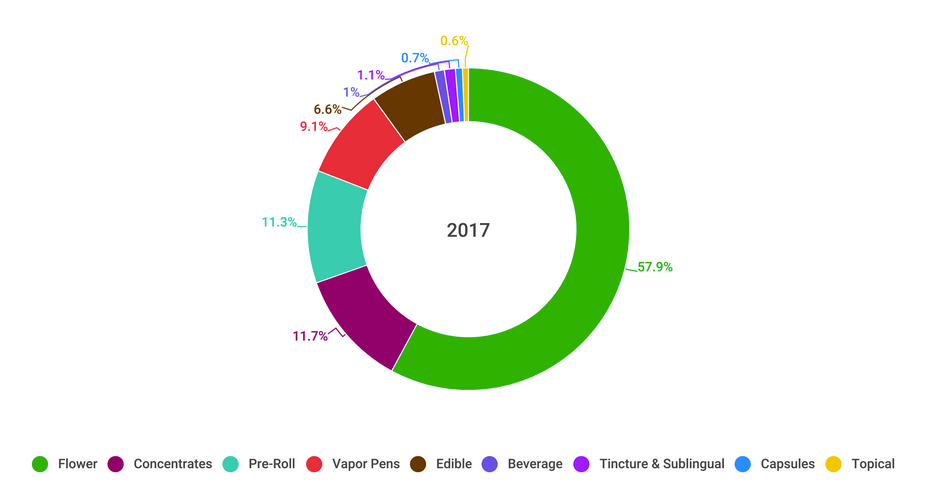Even though legal cannabis has been around for more than two decades in the U.S., this is still news to many: Smoking is not the only way to consume weed. As the industry evolves, so do intake methods.
You probably know about vaping and edibles, but have you ever heard about concentrates?
The list of products comprised in the concentrates category is pretty vast, ranging from things like wax, shatter and live resin to hash. However, they all have one thing in common: They are cannabis-plant extracts. So, even though extraction methods vary, the end products are substantially more potent than regular old cannabis flowers or buds, and usually conceived as “cleaner,” since they tend to not involve smoking in the more traditional sense of the word.
On The Come Up
Headset is a data and analytics firm for the cannabis industry. It generates market and retailer-direct data as well as business intelligence. In a recent report titled “On the Come Up: Concentrates Category Shows Consistent Growth,” Headset shared a detailed look into consumption trends and demographics. As per the analysis based on real-time sales data from participating cannabis retailers in Washington state*, concentrates have gained considerable traction over the last year, becoming the second most popular category after dried flower.
Representing 11.7 percent of July 2017 sales — up from 10.3 percent in the same period last year, concentrates displaced pre-rolled joints from its runner up position, mostly driven by demand among millennials.
Related Link: Rodney And Holly Robinson Peete Talk About Hemp Cream For Pain Relief
Interested in this emerging trend, Benzinga reached out to the company’s CEO and co-founder Cy Scott, original co-founder of Leafly, one of the top cannabis media outlets in the world, and asked him to share some insights.
Understanding Weed Products
Headset divides cannabis products into nine categories. The chart below illustrates the percentage of total sales each represents. Notice that vapor pens are listed as an individual category, even though many of them work with concentrates.
 Source: Headset
Source: Headset
As it can be appreciated above, flower sales make up almost 58 percent of the market, with concentrates and pre-rolls following suit, boasting 11.7 percent and 11.3 percent market shares, respectively.
One of the interesting things Headset analysts picked up was the amount of “distinct items” being sold, which accounted for more than 50 percent of total sales. “We are seeing a large number of new products being introduced,” Scott told Benzinga. “This could either indicate that people are helping drive those sales by introducing new products to the market, or that people are seeing that sales are going up for the concentrates category, and are thus investing in that space and starting to produce concentrates like wax and shatter.”
Understanding Demand
The CEO pointed out that many people recur to them because they provide a “cleaner” consumption experience when compared to dried flower, when asked why he thought concentrates were witnessing such growth. As explained above, most of these products are not actually smoked, but rather consumed in other ways.
Consequently, what most concentrates do require is specific paraphernalia; you need a specific device to consume a concentrate. To put it in plain English, using concentrates usually has more of a “stoner” feel to it, when compared to regular vaping, eating a cookie or even smoking a blunt. This could be one of the main reasons this category is especially popular among young people.
Related Link: Why Growing Marijuana In Israel Is A Good Idea: Cronos Group CEO Explains New Joint Venture
Males aged 25 and under spend about 25 percent of their total dollars on concentrates; this compares to just 7.5 percent for males over 50. “While the magnitude is muted in females the trend is the same with females under 25 spending about 16 percent of their total dollars on concentrates, compared to about 6 percent for females over 50,” Scott said.
“There’s a convenience factor involved,” he added.
*How do the results from Washington state extrapolate to the rest of the country? “We chose Washington because our footprint is very large; we track almost 50 percent of every dollar spent in the market,” Scott explained. “We were able to peg that against the state trace-ability data, looking at tax revenue, sales and other number that the state publishes, and we benchmark against that. That is how we were able to extrapolate out to the full market size ... Other markets like Colorado and California are definitely close in terms of numbers, and we see some similarities, but we can't assure it's exactly the same numbers. We'll soon have data for other marijuana markets, though.”
Image Credit: Javier Hasse
© 2025 Benzinga.com. Benzinga does not provide investment advice. All rights reserved.
Comments
Trade confidently with insights and alerts from analyst ratings, free reports and breaking news that affects the stocks you care about.